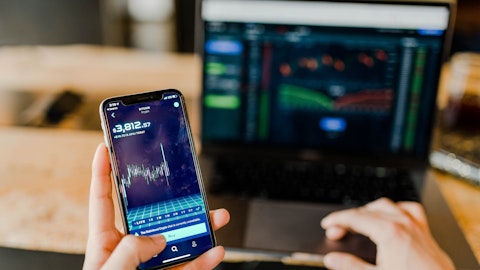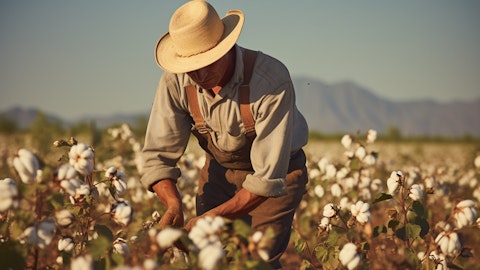Operator: Our next question comes from Salvator Tiano of Bank of America. Salvator, please go ahead.
Salvator Tiano: Yes, thank you very much. I just want to go back to the 2025 target of $6, $7 in EPS. I mean, that is obviously double digit EPS growth and I understand buybacks play a role into that. But given the comments about controllables versus cyclicals, it seems really tough to imagine getting back there. Can you provide a little bit some of the key components and key buckets that you think will get you there in terms of its segment and specific numbers as detailed as possible?
Ismael Roig: Yes, Salvator listen, a little bit of what I explained early on Adam’s question. I think that we will see how the cycle plays in ASNO. As I said, I think that lower prices have this ability to incentivate demand. At this point in time If you think about soybean meal demand, we are forecasting a very strong soybean meal demand, maybe higher than USDA levels, higher than GDP. When you think about Southeast Asian economies recovering and with inflation moderating, purchasing power is improving, tourism is improving in all those areas, you have at the moment very high prices of beef that’s favoring pork and chicken. You have protein margins for chicken being better at that. So we think that soybean meal will gain in the Russian.
So when we look at all that, we see the soy oil demand very strong in domestic consumption, but also for biofuels, and then we see the meal demand very strong. We think that this correction should be probably short term for crash and that should come back again. I cannot make a prediction on the timing of that, but we know how the cycle plays. So whether it’s calendar year this or six months later or a quarter earlier, it’s not for me to venture into those guesses. I think that carb solutions between the exceptional job they are doing on managing their mature businesses and the growth that they are getting through decarbonization and BioSolutions, you will see that ahead of us. Again, we just bring in the Marshall expansion. That’s not something that it was in our forecast last year.
So we’re going to have it more in the next three quarters, if you will, of the year, Spiritwood again, and some of the crash capacity we brought in Brazil, and then you see nutrition. That nutrition was not a contributor, certainly a big contributor to growth in 2023, but we expect it to be back to growth in 2024 and 2025. So those are kind of the buckets, if you will, that I see at the moment.
Operator: Thank you. Our next question comes from Steven Haynes of Morgan Stanley. Steven, the line is yours.
Steven Haynes: Hey, good morning. Thanks for taking my question. Maybe just to come back to nutrition, I think in your prepared remarks you talked about some portfolio refreshment going on there and was wondering if you could maybe size, the scope of that. Are you thinking more kind of product line oriented here, or is this kind of more at the business level where you might be looking to monetize something? Thank you.
Juan Luciano: Yes, Steven, listen, let me give you my thinking on that and the way we approach these things. So we always look, every time we do our five year plan, we take a look at those units that whether they are not returning, given our return expectations to date, we’re not forecasting it to do it in the medium term. And those are the ones that we tend to take action. So we took action with a couple of joint ventures, as I mentioned, and then we look at every unit that is underperforming. What we do first is we try to bring them to performance. So we make sure that if there are some things that are self-inflicted, if you will, we correct those things. Once we correct those things, and then we have visibility to what could happen over the next two or three years, then we decide as a part of portfolio whether they belong in nutrition or they belong in another part of ADM, or they belong outside ADM.
So that’s a regular process. We done, we done it in the past with fertilizers, Latin America, we’ve done it in the past. We divested Bolivia. We divested cocoa and chocolate. So we’ve done this, and now we’ve done it with a couple of joint ventures. We’ve done it also. Ismael has done it in his previous job as an Animal Nutrition leader with some of the lines in Animal Nutrition that we cut, like 20 lines around the world. So sometimes we have exited countries. So it’s a regular process that at times, maybe when you have a stumble like we had in nutrition, you look a little bit deeper, because now, all of a sudden, you have more businesses at lower performance. So we really want to see, is it worth investing in some of those? So we’re in that process.
So, nothing to announce today, but we continue to look at that very deeply.
Ismael Roig: Just a couple of complimentary comments, because not only have we had some experience historically, as Juan correctly mentions, with [indiscernible] and fertilizer, but certainly the Animal Nutrition was a good precursor to some of the thinking that we have now in mind for the whole of our nutrition business. In the sense that usually when you acquire these businesses, they come with footprint allocations, labs, farms, in our cases, and warehouses, that when you aggregate them, start aggregate them across a number of different acquisitions, you realize that there are overlaps. And what we noticed is that there was a significant opportunity in Animal Nutrition to significantly simplify the portfolio by reducing the number of labs, reducing the number of SKUs of plants.
And we’ve seen those benefits. They’ve been occurring since the second half of 2023. And I think that some of that thinking, as we have built this organization via a multiplicity of acquisitions, lends itself now to a pause and reflection, in light of the successes that we’ve had with this, to apply it more broadly to all of the portfolio. So that’s where our capital prudence is going to come in, by focusing on ensuring that we improve our asset base while returning cash to our shareholders.
Steven Haynes: Thank you, Ismael.
Operator: Thank you. Our next question comes from Dushyant Ailani of Jefferies. Dushyant, please go ahead.
Dushyant Ailani: Thank you for squeezing me in. I just wanted to quickly talk about biodiesel margins going forward. Your thoughts just around the system, both in the U.S. and internationally, just how do we frame our thoughts around that and capacity as well?
Juan Luciano: Yes. Thank you, Dushyant. Well, all useful biofuel production is, as I said, is expected to grow in Brazil. We’re going to go to B14, so there are many countries that are increasing their mandates, whether it’s Indonesia and all that. When you look at the overall balances around the world, you see plantations in Southeast Asia getting older, the trees getting older, so maybe less production of palm oil. So you’re going to see biodiesel mandates increasing around the world and less competitive pressure, if you will, for palm oil. So you’re going to see the pressure on vegetable oil. So we think that that will continue to be a strong leg of the crash, biodiesel in particular. Biodiesel margins are better right now for us in Europe.
They have moderated significantly in the U.S., and we expect them to be good, but not as good as they used to be in the U.S. So that will be a little bit of a headwind for us in 2024. But margins are better in Brazil and in Europe. Thank you.
Operator: Thank you. With that, we have no further questions, so I’ll hand back to the management team for any closing remarks.
Megan Britt: Thank you for joining us today. Please feel free to follow up with me, if you have any other questions. Have a good day and thanks for your time and interest in ADM.
Operator: Ladies and gentlemen, this concludes today’s call. Thank you for joining. You may now disconnect your lines.





